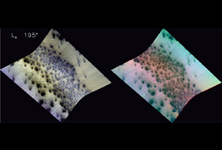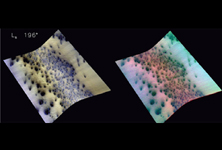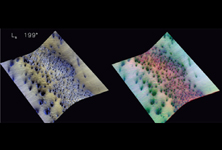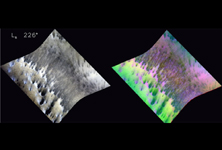 |  |
Frame #1
FRT00004959, Ls 195 | Frame #2
FRT000049C2, Ls 196 |
 |  |
Frame #3
FRT00004B45, Ls 199 | Frame #4
FRT000059E2, Ls 226 |
Mars' seasonal caps consist of frozen carbon dioxide mixed with smaller amounts of water ice frost and dust. The different composition of Mars' seasonal caps than Earth's seasonal caps (water-ice snow), plus the lower pressure of the Martian atmosphere, inevitably make springtime recession of the seasonal cap different than the snowmelt that characterizes retreat of Earth's seasonal cap. To monitor Mars' seasonal changes, CRISM repeatedly targets specific regions as Mars' seasons change. Results shown here are evidence that as warming carbon-dioxide ice vaporizes, some is trapped under the ice slab from which pressurized outbursts occur. The released gas expands, cools, and some of it refreezes and falls back to the surface as bright fans.
The region shown in this movie, known informally as Manhattan, is located at 86.3 degrees south latitude, 99 degrees east longitude. To represent the content of the spectral images, two versions of the data are shown side-by-side. The left image was constructed from extended visible wavelengths, to look similar to color images from the High Resolution Imaging Science Experiment (HiRISE) camera. The right image is infrared false-color, with red being the reflectance at 1.30 micrometers, green being depth of the water ice absorption centered at 1.5 micrometers, and blue being depth of the carbon dioxide ice absorption centered at 1.435 micrometers. In this color scheme, surfaces with higher water ice content will appear greenish, while bright carbon dioxide ice will appear magenta. Areas covered by dust will appear dark. In both images, north is to the right. The four time steps in the movie were taken at solar longitudes (Ls) ranging from 195 through 226. (Solar longitude is a measure of seasons, where 180 is southern spring equinox and 270 is southern summer solstice.)
The first frame (image FRT00004959, Ls 195) shows a number of spots and dark fan-shaped features, with a higher concentration of spots on a slope in the middle of the scene. The dark fans show multiple directions, generally indicating wind coming out of the east. The second frame (image FRT000049C2, Ls 196) was taken just a few days after the prior one and starts to show color variations in the fans.
The third frame (image FRT00004B45, Ls 199) records appearance of bright (bluish) fans in addition to the dark fans. The bright fans are slightly more bluish in the false-color image at right, indicating enrichment in carbon dioxide ice. The tails of the dark fans are more greenish, indicated a slight enhancement of water ice. The fourth and final frame (image FRT000059E2, Ls 226) shows distinct bright fans that appear magenta in the false-color image, indicating carbon dioxide ice with little evidence of water ice. However the surrounding surface is greenish, suggesting small amounts of water ice contamination. The tails of the dark fans appear to be more greenish in the infrared than the surrounding ice, suggesting a slight enhancement of the water ice contamination. The difference between the directions of dark and bright fans suggests changes in the wind direction, perhaps as part of a diurnal cycle or pattern.
CRISM science team members working with these data believe that they are seeing evidence for a process first proposed based on data from the Thermal Imaging System (THEMIS) instrument on Mars Odyssey. In this hypothesis, sunlight penetrating the ice warms the underling soil and causes carbon dioxide frost to vaporize at its base. At first the gas is trapped under the frost; when it is released, the expanding gas cools and part of it refreezes to form carbon dioxide frost in the magenta-colored fans.
The Compact Reconnaissance Imaging Spectrometer for Mars (CRISM) is one of six science instruments on NASA's Mars Reconnaissance Orbiter. Led by The Johns Hopkins University Applied Physics Laboratory, the CRISM team includes expertise from universities, government agencies and small businesses in the United States and abroad.
CRISM's mission: Find the spectral fingerprints of aqueous and hydrothermal deposits and map the geology, composition and stratigraphy of surface features. The instrument will also watch the seasonal variations in Martian dust and ice aerosols, and water content in surface materials—leading to new understanding of the climate.

